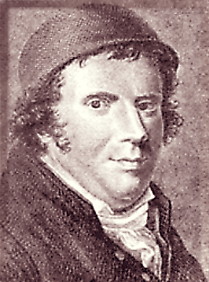Israel Jacobson
Israel Jacobson (October 17, 1768, Halberstadt – September 14, 1828, Berlin) was a German philanthropist and, according to Borowitz and Patz in Explaining Reform Judaism (1985), is considered the "father" of the Reform movement in Judaism.
Origins
The only son of wealthy businessman and philanthropist Israel Jacob, Jacobson's parents lived modestly yet contributed considerably to reducing the community debt. Owing to the very low level of efficiency of the Halberstadt public schools, Israel attended mainly the Jewish religious school, in his leisure hours studying German literature and the works of Gotthold Ephraim Lessing and Moses Mendelssohn on his own account. His level of understanding of rabbinic literature and Hebrew led professors at the University of Helmstedt, where he was eventually granted a degree, to declare that Jacobson was a Hebrew scholar.
At the age of eighteen, after having accumulated a small fortune, he married Mink Samson, the daughter of respected financier Herz Samson and granddaughter of Philip Samson, founder of the Samson-Schule at Wolfenbüttel, at which Leopold Zunz and Isaak Markus Jost were educated. Through the Samson family, Jacobson became friends with Charles William Ferdinand, Duke of Brunswick, favorite nephew of Frederick II of Prussia. Jacobson took up his residence in Brunswick and, possessing great financial ability, rapidly increased his fortune. Developing a belief in egalitarian and religious pluralism in education, he established (1801) in Seesen, near the Harz Mountains, a school in which forty Jewish and twenty Christian children were to be educated together, receiving free board and lodging. This close association of children of different creeds was a favorite idea of his. The Jacobson school soon obtained a wide reputation, and hundreds of pupils from neighboring places were educated there. During the hundred years of its existence, it has stood foremost in every line of educational work.
Accomplishments
Jacobson very soon perceived the necessity of imbuing the young as early as possible with proper religious impressions. In 1810 he built a beautiful temple within the school grounds and showed his Reform sympathies by supplying it with an organ, the first instance of the placing of an organ in a Jewish house of worship. Hymns in German were sung by the boys; and prayers in German were added to those in Hebrew. The progressive nature of his views was further shown by his strong advocacy of the introduction of confirmation. In the Seesen temple it was Jacobson himself who confirmed the first five Jewish boys. When, under Napoleon's rule, the Kingdom of Westphalia was created, and the emperor's brother Jerome was placed at its head, Jacobson, who had removed to the residence of the king at Cassel, was appointed president of the Jewish consistory. In this capacity, assisted by a board of officers, he did his best to exercise a reforming influence upon the various congregations of the country. He opened a house of prayer in Cassel, with a ritual similar to that introduced in Seesen; he also advocated a seminary for the training of Jewish teachers.
Reform religious innovations were egalitarian and based on Enlightenment thinking and reason. With Jacobson's services from the beginning of the 19th century, there was no longer references to a liberating Messiah who would reintroduce the state of Israel. Worshippers were no longer required to cover their heads, and there also came an end to daily public worship. Work was allowed on the Sabbath, and the dietary laws were abandoned. Women and men worshiped and studied together; liturgy stressed congregational readings in unison, sermons from the pulpit and a respectful environment; ethics were taught and discussed.
After Napoleon's fall (1815) Jacobson moved to Berlin, where also he continued to introduce reforms in beliefs and divine service. For this purpose he opened in his own house a hall for worship in which eloquent sermons were delivered by Zunz, Eduard Kley, and Isaak Lewin Auerbach. However, the Prussian government, remembering the French sympathies of Jacobson, and receiving continued complaints from the Orthodox rabbis, ordered the services discontinued. However, it was through Jacobson's influence and persuasion that the so-called "Leibzoll" (poll-tax) was abolished.
Throughout his life Jacobson seized every opportunity to promote a cordial understanding between Jews and Christians, and his great wealth enabled him to support many poor of both faiths.
ReferencesISBN links support NWE through referral fees
- Bibliography: Allgemeine Deutsche Biographie, xiii.619;
- Fürst, Bibl. Jud. ii.6.
- This article incorporates text from the 1901–1906 Jewish Encyclopedia article "Jaconson, Israel" by Isidore Singer and H. Baar, a publication now in the public domain.
- Marcus, Jacob Rader (1972) Israel Jacobson: The Founder of the Reform Movement in Judaism. Cincinnati: Hebrew Union College Press. ISBN 0-87820-000-2.
Credits
New World Encyclopedia writers and editors rewrote and completed the Wikipedia article in accordance with New World Encyclopedia standards. This article abides by terms of the Creative Commons CC-by-sa 3.0 License (CC-by-sa), which may be used and disseminated with proper attribution. Credit is due under the terms of this license that can reference both the New World Encyclopedia contributors and the selfless volunteer contributors of the Wikimedia Foundation. To cite this article click here for a list of acceptable citing formats.The history of earlier contributions by wikipedians is accessible to researchers here:
The history of this article since it was imported to New World Encyclopedia:
Note: Some restrictions may apply to use of individual images which are separately licensed.
